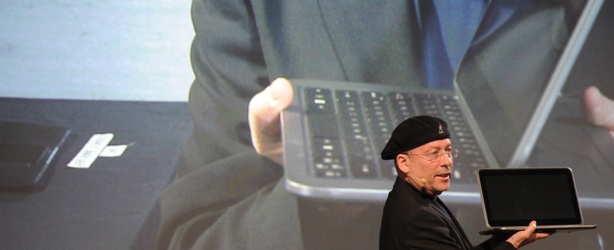The Best of the 2012 International CES
January 14, 2012 | 07:32

Intel goes on an Ultrabook offensive
If the 2011 CES was tablet-heavy, 2012 is the year of the Ultrabook. While some manufacturers were still clinging on to the touch-centric paradigm - in particular Lenovo, which was showing off the IdeaPad Yoga Ultrabook-cum-tablet running a developer preview of Windows 8 with the Metro UI - the majority of companies have found a new bandwagon on which to jump.

Intel's Nikiski concept is certainly swish
Highlights of the devices on display include: Intel's own Nikiski concept, which features a transparent touchpad region, allowing a portion of the screen to remain visible while the device is closed; HP's Envy Spectre, the company's first true Ultrabook and one made mostly out of toughened glass; and another Intel concept that borrows heavily from the Asus Eee Pad Slider.
Intel also used the event to make some promises about the technology that will find its way into Ultrabooks of the future. The announcement of a strategic partnership with voice recognition specialist Nuance, creator of the Dragon range of dictation software, suggests the company is looking at Apple's Siri for innovation; while Intel vice president Mooley Eden told attendees to expect multiple touch-screen devices like the IdeaPad Yoga - to be sub-branded 'Ultrabook with Touch' by Intel - over the coming year.

Intel's Slider looks a bit familiar
Finally, AMD had an announcement of its own to make: a rival ultra-portable platform based on Trinity second-generation Bulldozer parts, drawing just 17W while undercutting Intel's Ultrabook platform in price.
If the 2011 CES was tablet-heavy, 2012 is the year of the Ultrabook. While some manufacturers were still clinging on to the touch-centric paradigm - in particular Lenovo, which was showing off the IdeaPad Yoga Ultrabook-cum-tablet running a developer preview of Windows 8 with the Metro UI - the majority of companies have found a new bandwagon on which to jump.

Intel's Nikiski concept is certainly swish
Highlights of the devices on display include: Intel's own Nikiski concept, which features a transparent touchpad region, allowing a portion of the screen to remain visible while the device is closed; HP's Envy Spectre, the company's first true Ultrabook and one made mostly out of toughened glass; and another Intel concept that borrows heavily from the Asus Eee Pad Slider.
Intel also used the event to make some promises about the technology that will find its way into Ultrabooks of the future. The announcement of a strategic partnership with voice recognition specialist Nuance, creator of the Dragon range of dictation software, suggests the company is looking at Apple's Siri for innovation; while Intel vice president Mooley Eden told attendees to expect multiple touch-screen devices like the IdeaPad Yoga - to be sub-branded 'Ultrabook with Touch' by Intel - over the coming year.

Intel's Slider looks a bit familiar
Finally, AMD had an announcement of its own to make: a rival ultra-portable platform based on Trinity second-generation Bulldozer parts, drawing just 17W while undercutting Intel's Ultrabook platform in price.

MSI MPG Velox 100R Chassis Review
October 14 2021 | 15:04








Want to comment? Please log in.